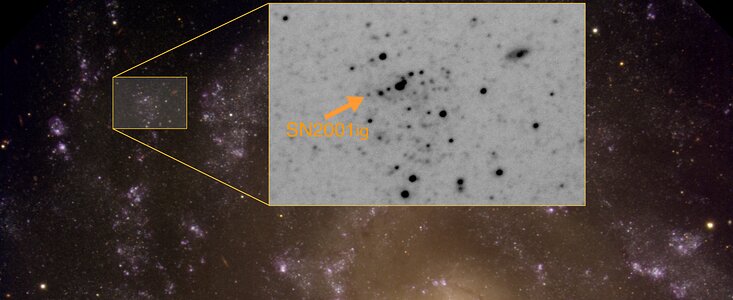Companion Explains "Chameleon" Supernova
Based on Anglo-Australian Observatory (Sydney, Australia) Press Release
3 Mayo 2006
Using the Gemini South telescope in Chile, Australian astronomers have found a predicted "companion" star left behind when its partner exploded as a very unusual supernova. The presence of the companion explains why the supernova, which started off looking like one kind of exploding star, seemed to change its identity after a few weeks.
The Gemini observations were originally intended to be reconnaissance for later imaging with the Hubble Space Telescope. “But the Gemini data were so good we got our answer straight away,” said lead investigator, Dr. Stuart Ryder of the Anglo-Australian Observatory (AAO).
Renowned Australian supernova hunter Bob Evans first spotted supernova 2001ig in December 2001. It lies in the outskirts of a spiral galaxy NGC 7424, which is about 37 million light-years away in the southern constellation of Grus (the Crane).
The supernova was monitored over the next month by optical telescopes in Chile. Supernovae are classified according to the features in their optical spectra. SN2001ig initially showed the telltale signs of hydrogen, which had it tagged as a Type II supernova, but the hydrogen later disappeared, which put it into the Type I category.
But how could a supernova change its type? Only a handful of such supernovae, classified as "Type IIb" to indicate their curious change of identity, have ever been seen. Only one (called SN 1993J) was closer than SN 2001ig.
Astronomers studying SN1993J had suggested an explanation: the supernova’s progenitor had a companion star that stripped material off the star before it exploded. This would leave only a little hydrogen on the progenitor—so little that it could disappear from the supernova spectrum within a few weeks.
A decade later observations with the orbiting Hubble Space Telescope and one of the Keck telescopes in Hawai’i confirmed that SN 1993J did indeed have a companion. Ryder and colleagues wondered if SN2001ig might have had a companion as well.
Radio Light Curve Shows Lumps & Bumps
Radio observations also hinted at a companion
Soon after SN 2001ig was discovered, Ryder and his colleagues began monitoring it with a radio telescope, the CSIRO (Commonwealth Scientific and Industrial Research Organisation) Australia Telescope Compact Array in eastern Australia. The radio emission did not fall off smoothly over time but instead showed regular bumps and dips. This suggested that the material in space around the star that exploded—which must have been shed late in its life—was unusually lumpy.
Although the lumps might have represented matter periodically shed from the convulsing star, their spacing was such that another explanation seemed more likely: that they were generated by a companion in an eccentric orbit. As it orbited, the companion would have swept material shed by the progenitor into a spiral (pinwheel) pattern, with denser lumps at the point in the orbit—periastron—where the two stars approached most closely.
Such spirals have been imaged around hot, massive stars called Wolf-Rayet stars by Dr Peter Tuthill of the University of Sydney, using the Keck telescopes. The bumps in the radio light-curve of SN 2001ig were spaced in a way consistent with the curvature of one of the spirals Tuthill has imaged.
“Stellar evolution theory suggests that a Wolf-Rayet star with a massive companion could produce this unusual kind of supernova,” said Ryder.
If the supernova progenitor had a companion, it might be visible when the supernova debris had cleared. So the astronomers put in a request to observe with the GMOS (Gemini Multi-Object Spectrograph) camera on the 8-meter Gemini South telescope.
When the time came to observe, the "seeing conditions" (stability of the atmosphere) were excellent. Just an hour and a half was needed to image the supernova field—and reveal a yellow-green point-like object at the location of the supernova explosion.
“We believe this is the companion,” said Ryder. “It’s too red to be a patch of ionized hydrogen, and too blue to be part of the supernova remnant itself.”
The companion has a mass of between 10 and 18 times that of the Sun. The astronomers hope to use GMOS again in coming months to get a spectrum of the companion, to refine this estimate.
Binary companions could explain much of the diversity seen in supernovae, Ryder suggests. “We’ve been able to show the chameleon-like behaviour of SN 2001ig has a surprisingly simple explanation,” he said.
This is only the second time a companion star to a Type IIb supernova has been imaged, and the first time the imaging has been done from the ground.
Más Información
A paper on the observations, “A post-mortem investigation of the Type IIb supernova 2001ig", co-authored by Ryder, University of Tasmania graduate student Clair Murrowood and former AAO astronomer Dr Raylee Stathakis, was published online in Monthly Notices of the Royal Astronomical Society on May 2. It is also available HERE.
Contactos
Helen Sim
Anglo-Australian Observatory
Sydney, Australia
Tel: +61(2)9372-425
Cel: +61-4196-35905
Correo electrónico: hsim@aaoepp.aao.gov.au
Dr. Stuart Ryder
Anglo-Australian Observatory
Sydney, Australia
Tel: +61(2)9372-4843
Cel: +61-419-970-834
Correo electrónico: sdr@aaoepp.aao.gov.au
Peter Michaud
Gemini Observatory
Hilo, Hawai‘i
Tel: (808) 974-2515
Cel: 808-936-6648
Correo electrónico: pmichaud@gemini.edu
About the Release
| Release No.: | gemini0604 |
| Nombre: | NGC 7424, SN 1993J, SN 2001ig |
| Facility: | Gemini South |
| Instruments: | GMOS-S |
| Science data: | 2006MNRAS.369L..32R |


